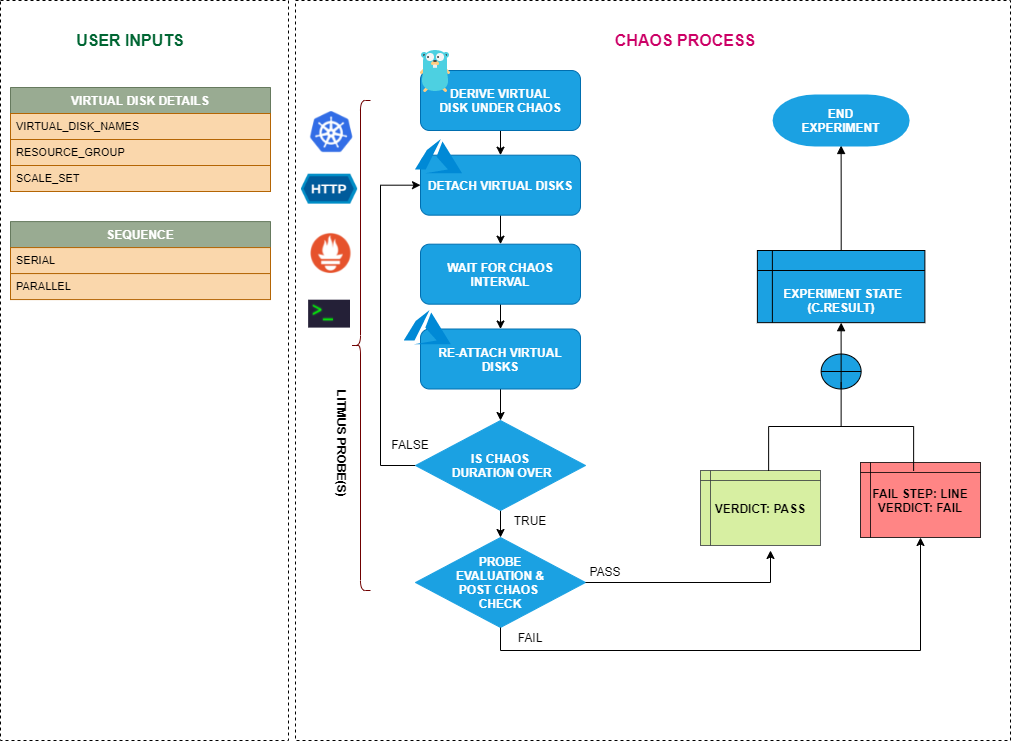Azure Disk Loss
Introduction¶
- It causes detachment of virtual disk from an Azure instance before re-attaching it back to the instance after the specified chaos duration.
- It helps to check the performance of the application/process running on the instance.
Scenario: Detach the virtual disk from instance

Uses¶
View the uses of the experiment
coming soon
Prerequisites¶
Verify the prerequisites
- Ensure that Kubernetes Version > 1.16
- Ensure that the Litmus Chaos Operator is running by executing
kubectl get podsin operator namespace (typically,litmus).If not, install from here - Ensure that the
azure-disk-lossexperiment resource is available in the cluster by executingkubectl get chaosexperimentsin the desired namespace. If not, install from here - Ensure that you have sufficient Azure access to detach and attach a disk.
- We will use azure file-based authentication to connect with the instance using azure GO SDK in the experiment. For generating auth file run
az ad sp create-for-rbac --sdk-auth > azure.authAzure CLI command. -
Ensure to create a Kubernetes secret having the auth file created in the step in
CHAOS_NAMESPACE. A sample secret file looks like:apiVersion: v1 kind: Secret metadata: name: cloud-secret type: Opaque stringData: azure.auth: |- { "clientId": "XXXXXXXXX", "clientSecret": "XXXXXXXXX", "subscriptionId": "XXXXXXXXX", "tenantId": "XXXXXXXXX", "activeDirectoryEndpointUrl": "XXXXXXXXX", "resourceManagerEndpointUrl": "XXXXXXXXX", "activeDirectoryGraphResourceId": "XXXXXXXXX", "sqlManagementEndpointUrl": "XXXXXXXXX", "galleryEndpointUrl": "XXXXXXXXX", "managementEndpointUrl": "XXXXXXXXX" } -
If you change the secret key name (from
azure.auth) please also update theAZURE_AUTH_LOCATIONENV value onexperiment.yamlwith the same name.
Default Validations¶
View the default validations
- Azure Disk should be connected to an instance.
Minimal RBAC configuration example (optional)¶
NOTE
If you are using this experiment as part of a litmus workflow scheduled constructed & executed from chaos-center, then you may be making use of the litmus-admin RBAC, which is pre installed in the cluster as part of the agent setup.
View the Minimal RBAC permissions
---
apiVersion: v1
kind: ServiceAccount
metadata:
name: azure-disk-loss-sa
namespace: default
labels:
name: azure-disk-loss-sa
app.kubernetes.io/part-of: litmus
---
apiVersion: rbac.authorization.k8s.io/v1
kind: Role
metadata:
name: azure-disk-loss-sa
namespace: default
labels:
name: azure-disk-loss-sa
app.kubernetes.io/part-of: litmus
rules:
# Create and monitor the experiment & helper pods
- apiGroups: [""]
resources: ["pods"]
verbs: ["create","delete","get","list","patch","update", "deletecollection"]
# Performs CRUD operations on the events inside chaosengine and chaosresult
- apiGroups: [""]
resources: ["events"]
verbs: ["create","get","list","patch","update"]
# Fetch configmaps & secrets details and mount it to the experiment pod (if specified)
- apiGroups: [""]
resources: ["secrets","configmaps"]
verbs: ["get","list",]
# Track and get the runner, experiment, and helper pods log
- apiGroups: [""]
resources: ["pods/log"]
verbs: ["get","list","watch"]
# for creating and managing to execute comands inside target container
- apiGroups: [""]
resources: ["pods/exec"]
verbs: ["get","list","create"]
# for configuring and monitor the experiment job by the chaos-runner pod
- apiGroups: ["batch"]
resources: ["jobs"]
verbs: ["create","list","get","delete","deletecollection"]
# for creation, status polling and deletion of litmus chaos resources used within a chaos workflow
- apiGroups: ["litmuschaos.io"]
resources: ["chaosengines","chaosexperiments","chaosresults"]
verbs: ["create","list","get","patch","update","delete"]
Use this sample RBAC manifest to create a chaosServiceAccount in the desired (app) namespace. This example consists of the minimum necessary role permissions to execute the experiment.
Experiment tunables¶
check the experiment tunables
Mandatory Fields
| Variables | Description | Notes |
|---|---|---|
| VIRTUAL_DISK_NAMES | Name of virtual disks to target. | Provide comma separated names for multiple disks |
| RESOURCE_GROUP | The resource group of the target disk(s) |
Optional Fields
| Variables | Description | Notes |
|---|---|---|
| SCALE_SET | Whether disk is connected to Scale set instance | Accepts "enable"/"disable". Default is "disable" |
| TOTAL_CHAOS_DURATION | The total time duration for chaos insertion (sec) | Defaults to 30s |
| CHAOS_INTERVAL | The interval (in sec) between successive instance poweroff. | Defaults to 30s |
| SEQUENCE | It defines sequence of chaos execution for multiple instance | Default value: parallel. Supported: serial, parallel |
| RAMP_TIME | Period to wait before and after injection of chaos in sec |
Experiment Examples¶
Common Experiment Tunables¶
Refer the common attributes to tune the common tunables for all the experiments.
Detach Virtual Disks By Name¶
It contains comma separated list of disk names subjected to disk loss chaos. It can be tuned via VIRTUAL_DISK_NAMES ENV.
Use the following example to tune this:
# detach multiple azure disks by their names
apiVersion: litmuschaos.io/v1alpha1
kind: ChaosEngine
metadata:
name: engine-nginx
spec:
engineState: "active"
annotationCheck: "false"
chaosServiceAccount: azure-disk-loss-sa
experiments:
- name: azure-disk-loss
spec:
components:
env:
# comma separated names of the azure disks attached to VMs
- name: VIRTUAL_DISK_NAMES
value: 'disk-01,disk-02'
# name of the resource group
- name: RESOURCE_GROUP
value: '<resource group of VIRTUAL_DISK_NAMES>'
- name: TOTAL_CHAOS_DURATION
value: '60'
Detach Virtual Disks Attached to Scale Set Instances By Name¶
It contains comma separated list of disk names attached to scale set instances subjected to disk loss chaos. It can be tuned via VIRTUAL_DISK_NAMES and SCALE_SET ENV.
Use the following example to tune this:
# detach multiple azure disks attached to scale set VMs by their names
apiVersion: litmuschaos.io/v1alpha1
kind: ChaosEngine
metadata:
name: engine-nginx
spec:
engineState: "active"
annotationCheck: "false"
chaosServiceAccount: azure-disk-loss-sa
experiments:
- name: azure-disk-loss
spec:
components:
env:
# comma separated names of the azure disks attached to scaleset VMs
- name: VIRTUAL_DISK_NAMES
value: 'disk-01,disk-02'
# name of the resource group
- name: RESOURCE_GROUP
value: '<resource group of VIRTUAL_DISK_NAMES>'
# VM belongs to scaleset or not
- name: SCALE_SET
value: 'enable'
- name: TOTAL_CHAOS_DURATION
value: '60'
Multiple Iterations Of Chaos¶
The multiple iterations of chaos can be tuned via setting CHAOS_INTERVAL ENV. Which defines the delay between each iteration of chaos.
Use the following example to tune this:
# defines delay between each successive iteration of the chaos
apiVersion: litmuschaos.io/v1alpha1
kind: ChaosEngine
metadata:
name: engine-nginx
spec:
engineState: "active"
annotationCheck: "false"
chaosServiceAccount: azure-disk-loss-sa
experiments:
- name: azure-disk-loss
spec:
components:
env:
# delay between each iteration of chaos
- name: CHAOS_INTERVAL
value: '10'
# time duration for the chaos execution
- name: TOTAL_CHAOS_DURATION
value: '60'
- name: VIRTUAL_DISK_NAMES
value: 'disk-01,disk-02'
- name: RESOURCE_GROUP
value: '<resource group of VIRTUAL_DISK_NAMES>'